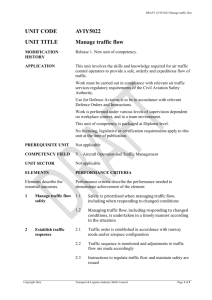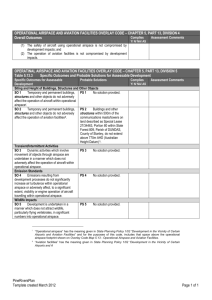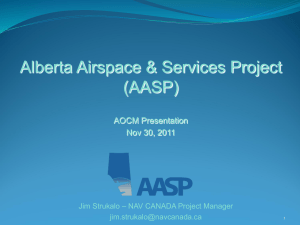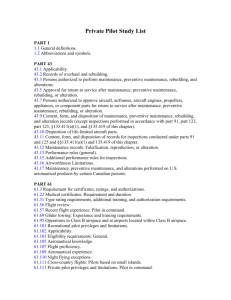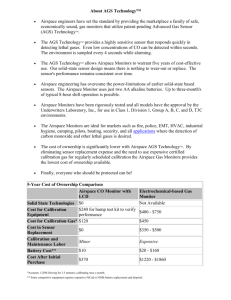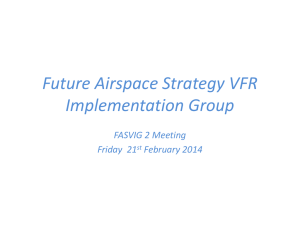Airspace - Flight Training
advertisement
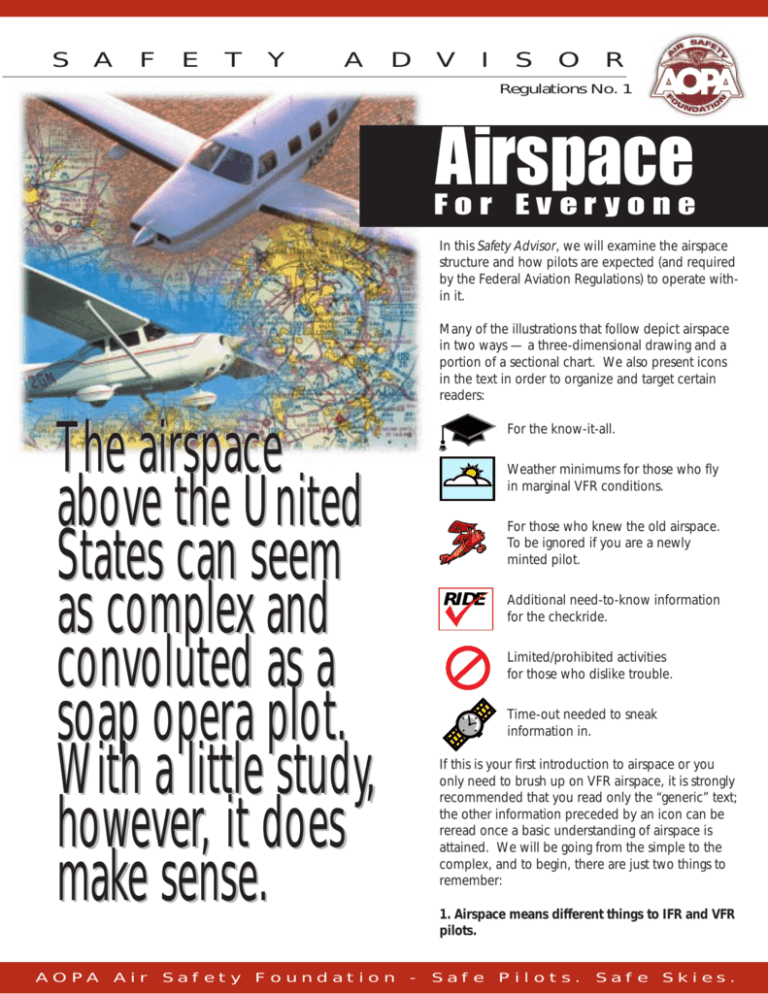
S A F E T Y A D V I S O R Regulations No. 1 Airspace For Everyone In this Safety Advisor, we will examine the airspace structure and how pilots are expected (and required by the Federal Aviation Regulations) to operate within it. Many of the illustrations that follow depict airspace in two ways — a three-dimensional drawing and a portion of a sectional chart. We also present icons in the text in order to organize and target certain readers: The airspace above the United States can seem as complex and convoluted as a soap opera plot. With a little study, however, it does make sense. A O PA Air Safety Foundation For the know-it-all. Weather minimums for those who fly in marginal VFR conditions. For those who knew the old airspace. To be ignored if you are a newly minted pilot. RIDE Additional need-to-know information for the checkride. Limited/prohibited activities for those who dislike trouble. Time-out needed to sneak information in. If this is your first introduction to airspace or you only need to brush up on VFR airspace, it is strongly recommended that you read only the “generic” text; the other information preceded by an icon can be reread once a basic understanding of airspace is attained. We will be going from the simple to the complex, and to begin, there are just two things to remember: 1. Airspace means different things to IFR and VFR pilots. - Safe Pilots. Safe Skies. 2. Flight within any airspace is dependent upon existing weather conditions and communications requirements. Throughout this Safety Advisor, we will be talking about VFR and IFR operations within different classes of airspace. VFR pilots need to know more about airspace than IFR pilots, because most airspace was designed to separate VFR and IFR operations. The simple act of being on an IFR flight plan means that clearances through controlled airspace have already been granted. Of course, pilots who are studying for FAA knowledge or practical tests will need to know everything — so bone up. Distilled to the basics, there are two kinds of airspace: uncontrolled and controlled. Uncontrolled Airspace In the early days of aviation, all airspace was uncontrolled, what we today call Class G airspace. Way back when, there were few airplanes, and none had the instruments necessary to fly in clouds. Traffic density, even at the busiest of airports, was very low, and the airplanes flew slowly. Although there were no standards for weather conditions aircraft could fly in, it was generally agreed that if you remained clear of clouds and had at least 1 mile visibility, you could see other airplanes and terrain in time to avoid a collision. This was called see and avoid. It formed the basis for VFR flight and remains critical to preventing collisions (see Figure 1). faded at night and at altitude, better weather conditions were necessary to see and avoid other traffic. This is the reason why higher weather minimums exist at night and at altitude. Minimum cloud clearance limits and flight visibilities worked well for a time, but the aviation industry was booming, and things were about to change. Except when flying in clouds, the pilot in command is responsible at all times for aircraft separation, even when operating in a radar environment or on an IFR flight plan. IFR flight in the clouds is permitted in uncontrolled airspace, provided that the pilot is instrument-rated and the aircraft is equipped for instrument flight. Controlled Airspace The Beginning With the advent of inexpensive gyroscopic flight instruments, travel through the clouds became possible. See and avoid was useless in the soup, so procedures to ensure aircraft separation were needed. This led to the creation of air traffic control (ATC) and controlled, or Class E, airspace. The government established a system of airways, each 8 nautical miles wide with base altitudes of 1,200 feet above ground level (agl), and designated the airspace within them as controlled airspace. The airway system was defined by a network of radio beacons, many of which were located on airports. This network of radio aids replaced a system of ground-based airway lights that were an important part of the air-mail pilots’ arsenal of survival. Figure 1. The Early Days More stringent weather minimums for VFR operations were established for this controlled airspace to further separate air traffic. In poor weather conditions, pilots and aircraft had to be qualified and equipped for IFR flight, file IFR flight plans, and coordinate their positions with ATC. When weather conditions were good, pilots could still fly on IFR flight plans if they chose but were responsible to see and avoid other aircraft. Figure 2 shows how the airspace looked in those days. As the aviation population gained experience flying in marginal weather, pilots learned that because vision Some parcels of airspace contained many airways, so in those areas, controlled airspace was established at 1,200 Safe Pilots. Safe Skies. • Pg. 2 feet agl to coincide with the airways, whether on an airway or not. When VOR airways arrived in the 1950s, they were (and still are) known as “Victor” airways. Begin the Approaches Airport-based radio navigation facilities made instrument approaches possible, greatly improving the utility of aircraft while also creating some traffic-separation challenges. Close encounters between IFR airplanes on approach to airports and VFR airplanes flying under the weather led to the creation of transition areas. Transition areas surrounded airports with instrument approaches and brought Class E airspace to within 700 feet of the surface. This move was intended to protect approaching IFR pilots. Pilots flying under VFR could operate in the transition areas as long as they had VFR weather minimums (Figure 3 shows the magenta tint used to depict transition areas). Figure 2. Victor Airway Controlled airspace does not mean that all flight within it is controlled. It means that IFR services are available to qualified pilots who choose to use them. Pilots operating under VFR may fly freely in controlled airspace as long as weather conditions meet current regulatory requirements for that airspace. Remember, this was in the days before widespread radar coverage, so when the weather was poor, pilot position reporting and strict separation of VFR traffic from controlled airspace were critical. Aerobatics are prohibited on federal airways. Old-timers will remember that airways based on low-frequency radio beacons were originally designated by color. Figure 3. Transition Area At first, the only approaches were of the nonprecision variety. That is, they provided no vertical guidance. Pilots would fly to or from a navaid and, at the appropriate distance or time, would descend to predetermined altitudes. Depending upon the speed of the airplane and the height of obstacles surrounding the airport, a nonprecision approach might or might not be sufficient to get below the clouds and onto the runway. Safe Pilots. Safe Skies. • Pg. 3 Most approaches in the United States are nonprecision. New ones based on Global Positioning System (GPS) guidance are being added. To help pave the way for all-weather utility, the instrument landing system (ILS) was invented, providing vertical guidance in the form of an electronic glideslope. It remains the predominant precision approach system today. The microwave landing system (MLS) was supposed to supersede the ILS system in the late 1980s but has largely fallen by the wayside as the potential for much less expensive GPS precision approaches expands. The ILS systems brought airplanes to within 200 feet of the ground, and that caused some problems with VFR flight around airports with precision approaches. The solution was to bring Class E, or controlled airspace, to the surface and to raise the minimums so that VFR traffic was restricted during poor weather. VFR minimums for surface-based Class E airspace are: a 1,000-foot ceiling and 3 statute miles visibility. When the weather is better than that, VFR and IFR traffic can safely mix within surface-based Class E (see Figure 4). A weather observer or automatic weather observation equipment (ASOS or AWOS) must be available at airports surrounded by surface-based Class E. If weather information is not available, the airspace reverts to Class G with a Class E transition area, as shown in Figure 3. Aerobatics are prohibited in surface-based Class E airspace. Unless prior permission is granted by ATC, ultralight vehicles and unmanned free balloons above 2,000 feet agl are also prohibited within surface-based Class E airspace. Surface-based Class E used to be known as a control zone. View From the Tower As traffic increased at major airports, the need for control towers became apparent. Controllers in the tower were — and still are — responsible for sequencing arriving and departing airborne traffic and keeping things in order on the ground. Class D airspace was established around towered airports, and all pilots operating within it were required to communicate with the tower, regardless of weather conditions. The same weather minimums as those in surface-based Class E applied to Class D, as well. Figure 5 shows how Class D is charted. Class D airspace used to be known as an airport traffic area. When arriving or departing the primary airport in Class D airspace, communications must be established with the tower. Communications must also be established when operating to or from an outlying field within the Class D airspace. When the tower is not operating but weather information is available, the airspace reverts to surface-based Class E (Figure 4) — that is, during periods of below-VFR weather, aircraft must be operating under IFR. If weather information is not available, the airspace reverts to Class G as shown in Figure 3. Part-time control towers’ hours of operation are published in the Airport/Facilities Directory, as well as on sectional charts. Figure 4. Surface-Based Class E Safe Pilots. Safe Skies. • Pg. 4 and above. Approach control handles traffic below the floor of the center’s airspace. With radar surveillance to separate aircraft, ATC can reduce the distance between participating aircraft. Intended mainly to separate IFR traffic, ATC may assist VFR traffic by providing flight following. This service allows VFR pilots to receive safety advisories but does not relieve them of see-and-avoid responsibility. Flight following is available from ATC on a work-load-permitting basis. Airspace Restrictions for Traffic Separation Air travel continued to expand, and the mixture of fast Transport-category aircraft and general aviation around major airports was thought to be a safety risk. Figure 5. Class D RIDE In order to aid in the separation of fast and slow traffic, there is also a speed limit of 200 knots indicated airspeed below 2,500 feet agl within 4 nautical miles (nm) of the primary Class D airport. Aerobatics are prohibited in Class D airspace. Ultralight vehicles and unmanned free balloons above 2,000 feet agl are also prohibited within Class D airspace unless prior permission is granted by ATC. The Radar Age Ground-based surveillance radar was introduced to aid ATC in separating aircraft. It exists in many forms and areas of coverage. Today, it’s known mainly by two components, air route traffic control centers (or just “center”) and terminal radar approach control (Tracon, or “approach”). Center facilities mainly deal with enroute high-altitude traffic, typically at 10,000 feet The FAA hastened the development of radar and ATC following a midair collision between a Lockheed Constellation and a Douglas DC-6 over the Grand Canyon in the 1950s. Similarly, the FAA accelerated its plans for more stringent traffic separation and expanded use of controlled airspace after a midair collision between a Boeing 727 and a Cessna 172 in San Diego in 1978. As radar was exploited, the FAA designed new classes of airspace solely to separate IFR and VFR flights in areas of high traffic flow. These classes of airspace include TRSAs (terminal radar service areas), Class C, and Class B. Because TRSAs don’t have an equivalent in the ICAO world, they retain their name even though terminal control areas became Class B and airport radar service areas became Class C. Airspace in Detail: The TRSA In some Class D airspace, traffic sequencing is handled by radar approach together with the tower. In these areas, radar assists the tower outside its Class D airspace. Some of these areas are depicted on sectional charts and are called terminal radar service areas (TRSAs), as shown in Figure 6. TRSA radar only assists Safe Pilots. Safe Skies. • Pg. 5 the tower in Class D airspace; the two function independently. Radio participation in the TRSA is voluntary, though recommended, and the airspace within the TRSA maintains its original class designation. TRSAs are simply Class D airspace surrounded by airspace in which radar coverage is provided. Figure 7. Class C Figure 6. TRSA A TRSA is airspace that does not fit the requirements of Class C airspace but is too busy to be just Class D airspace. Technically, a TRSA is an “other type” of airspace rather than a type of controlled airspace. Airspace in Detail: Class C Another type of terminal radar service, Class C airspace (see Figure 7), has a mandatory communication requirement. Note the differences and similarities between Class C airspace and Class D airspace with a surrounding TRSA. Controlled-airspace weather minimums are the same for Class C and Class D airspace. To operate inside or above Class C airspace, all aircraft are required to have a Mode C transponder (up to 10,000 feet msl). In addition, two-way radio communication must be established when operating within Class C. Any aircraft wishing to depart or return to a satellite airport located within Class C airspace must contact ATC approach control prior to entering Class C. Speed is also restricted in Class C airspace to 200 knots below 2,500 feet agl within 4 nm of the primary airport. Aerobatics are prohibited in Class C airspace. Ultralight vehicles, unmanned free balloons above 2,000 feet agl, and parachute jumps are prohibited within Class C airspace without prior permission from ATC. The communication requirement needed to enter Class C airspace is fulfilled as soon as ATC repeats the call sign. However, once communication is established, pilots must comply with all ATC instructions or advise otherwise. Clearance to operate in Class C airspace is not assumed if the controller says, “Cessna 123AS, Safe Pilots. Safe Skies. • Pg. 6 To operate in Class B you must receive a clearance; i.e., “Cleared into Class Bravo airspace.” Unlike other airspace, receipt of a heading, altitude or transponder code does not constitute a clearance to enter Class B airspace. remain clear of Class C airspace,” even though radio contact has been made. Class C airspace used to be known as airport radar service areas (ARSAs). Airspace in Detail: Class B If you imagine Class C airspace as the small town that grew into a large community, then Class B is that same community a decade later. In order to sequence highspeed traffic into heavily used airports — such as in Los Angeles, Dallas-Fort Worth, or New York — ATC needed to guarantee separation of traffic farther from the airport. This meant that all aircraft would have to be positively controlled. Class B airspace provides for positive control of both VFR and IFR traffic. By enlarging the area of radar coverage, Class B airspace is able to provide separation to all aircraft through a mandatory communication requirement. Due to this increase in radar coverage and mandatory participation by all aircraft, cloud clearances are reduced to clear of clouds with 3 miles visibility. Class B airspace can be seen in Figure 8. RIDE A Mode C transponder is required within 30 nm of the primary Class B airport, up to 10,000 feet msl. This is called the Mode C veil, which exists even outside the normal boundaries of the Class B airspace proper. Special aeronautical charts, known as terminal area charts, are published specifically for Class B airspace. Exceptions are allowed for aircraft without an electical system. A 250-knot speed limit is imposed within the Class B airspace (just like the rest of the country under 10,000 feet msl), unless you are operating in airspace to an airport underneath the floor of Class B airspace or within a VFR corridor, in which case the speed limit is 200 knots (VFR corridors will be discussed later). Aerobatics are prohibited in Class B airspace. Ultralight vehicles, unmanned free balloons above 2,000 feet agl, and parachute jumps are also prohibited within Class B airspace without prior permission from ATC. Certain Class B primary airports are prohibited for studentpilot operations (see Appendix II on page 13). Many types of published VFR routes permit transitions around, under, and through busy and complex airspace. Some require a clearance from ATC, and others do not. There are four general types of VFR routes, described below: • VFR flyways are depicted on VFR terminal area charts and provide the pilot a route in which to transition under Class B airspace in an organized manner. Although these routes do not require a clearance, communication must be established and maintained with any other classes of airspace to be entered — Class C or D, for example. Caution must be exercised because other VFR traffic is likely to be flying the route also. Figure 8. Class B • VFR corridors are “holes” in Class B airspace, with specific horizontal and vertical boundaries through which pilots may transition the airspace without obtaining a clearance or maintaining communication with ATC Safe Pilots. Safe Skies. • Pg. 7 (see Figure 9). Pilots should be vigilant in looking outside the airplane because VFR traffic tends to cluster in these corridors. Airspace in Detail: Class A Because most aircraft that fly above 18,000 feet are capable of IFR, Class A airspace was designed to control them. Class A begins at 18,000 feet and goes to 60,000 feet (see Figure 10). IFR clearances are required for all aircraft in Class A airspace, so there are no VFR weather minimums. 18,000 msl Figure 9. VFR Corridor • Class B airspace VFR transition routes are used to accommodate VFR traffic through certain Class B airspace. These routes are defined on VFR terminal area charts and require a clearance as well as ATC-assigned altitudes. Their purpose is to minimize controller work load by allowing pilots to navigate on a published route through congested airspace. Pilots may receive ATC clearance by advising their position, altitude, route name desired, and direction of flight. Once clearance is received, strict adherence to the route and ATC instructions is required. These routes may not always be available due to traffic flow into or out of the primary airport. • Terminal area VFR routes are used to avoid Class B, C, and D airspace areas while operating in complex terminal airspace. These routes may include recommended altitudes and are described by prominent visual references or navigation aids. Special terminal area VFR charts were developed jointly by the FAA and industry to provide more specific navigation information than was available on VFR terminal area charts. Class B airspace used to be known as terminal control areas (TCAs). It’s good practice to read back Class B clearances to ensure that there are no misunderstandings between you, the VFR flight, and ATC. Figure 10. Class A Aerobatics are prohibited in Class A airspace. Ultralight vehicles and parachute jumps are also prohibited within Class A airspace without prior permission from ATC. Class A airspace used to be known as the positive control area (PCA). A Special VFR (SVFR) clearance is one that permits takeoffs and landings in conditions below basic VFR weather minimums (1,000foot ceiling and 3-sm visibility). It can be granted within the surface boundaries of Class B, C, D, and E airspace, unless there is a “NO SVFR” noted in the airport information block on the sectional or terminal area chart. SVFR requires at least 1 mile ground or flight visibility and the ability to remain clear of clouds. At night, a SVFR clearance requires that the pilot be instrument-rated and the airplane be equipped for instrument flight. Safe Pilots. Safe Skies. • Pg. 8 Although SVFR clearance allows a pilot to operate in weather conditions below those specified for the airspace, appropriate measures must be taken to gain clearance into the approved SVFR area. An SVFR clearance only permits the pilot to operate in substandard VFR weather minimums in the selected airspace. Once clear of that airspace, standard weather minimums apply. sulting sectional chart legends. Restricted areas generally contain operations that do not mix well with aircraft such as artillery firing, guided missiles, or aerial gunnery. Permission to fly in restricted areas can be given by ATC. But Wait, There’s More Now that you know where you can go, it’s time to learn where you cannot. Beyond the two basic types of airspace discussed earlier (controlled and uncontrolled), there are two other types of airspace. Figure 11. Prohibited Area Special-Use Airspace Special-use airspace (SUA) was developed to advise pilots of an activity or surface area that dictates special rules or notices and may possibly be hazardous. There are five main types: • Prohibited areas are established for security reasons or for national welfare and are identified on aviation charts by a defined area marked with the letter “P,” followed by a number. Prohibited areas are for all intents and purposes permanently off limits. An example of a prohibited area is the White House or Camp David, as shown in Figure 11. Although these areas are charted, it is imperative to check notices to airmen (notams) before you fly. Some prohibited areas such as P-40 (Camp David in Thurmont, MD) and P-49 (the presidential ranch in Crawford, TX), may change often. A pilot flying “GPS-direct” from Frederick, MD to Hagerstown, MD was intercepted by fighter aircraft after penetrating P-40’s extended prohibited area. Pilots must be prepared to divert from normal flight operations to avoid TFR areas. Check notams, even for local flights. • Restricted areas, shown in Figure 12, though not entirely prohibited to flight activity, are areas in which unauthorized penetration is not only illegal, but also extremely dangerous. Restricted areas are identified on aviation charts by a defined area marked with the letter “R,” followed by a number. Altitudes and times differ for each restricted area and can be determined by con- Figure 12. Restricted Area • A warning area is airspace over international waters that extends from 3 miles beyond shore. Because the FAA has no authority over these areas, airspace that otherwise would be a restricted area cannot be legally enforced and thus becomes a warning area. Warning areas are advisory in nature and alert the pilots that they may be entering areas of hazardous activity (see Figure 13). • Military operations areas (MOAs), depicted in Figure 14, separate high-speed military traffic from general and commercial aviation. These areas are identified on aviation charts by a defined area marked with “MOA,” preceded by the MOA’s name. MOA altitudes differ for each individual area and can be determined by consulting sectional chart legends. Although VFR pilots are not prohibited from entering MOAs, they are cautioned to Safe Pilots. Safe Skies. • Pg. 9 keep a watchful eye out for military operations such as aerial refueling, air combat training, and formation flying. A pilot may contact a flight service station or ATC center within 100 miles of the MOA to determine if it is active and, if so, may request traffic advisories from the controlling agency prior to entry. • Military training routes (MTRs), as shown in Figure 15, are one-way high-speed routes for military traffic flying below 10,000 feet msl. They are depicted on sectional charts and are of two types: IR (IFR) and VR (VFR). Routes without a segment above 1,500 feet agl are charted with a four-number identifier, and routes with at least one segment above 1,500 feet agl are charted with a three-number identifier. Pilots flying along MTRs are encouraged to keep alert for military operations. A pilot may contact an FSS within 100 miles of the MTR to determine if it is active and, if so, may request times of scheduled activity, altitudes in use on each route segment, and actual route width (the route may extend several miles beyond the shown centerline). Not all MTRs are published on sectionals. In November of 2000, a Cessna 172 and an Air Force F16 fighter collided south of Tampa, Florida, just outside of the Tampa Class B and near the beginning of a lowaltitude military training route. The pilot of the Cessna, a 57-year-old flight instructor and charter pilot, was killed. The F-16 pilot ejected safely. Figure 13. Warning Area The Cessna pilot had been receiving VFR traffic advisories from the Tampa TRACON. The pair of F-16s had just been cleared onto a visual military training route (MTR) and were not communicating with ATC at the time of the accident. Military aircraft are permitted to exceed the 250-knot speed limit below 10,000 feet msI when cleared onto an MTR. Pilots should be aware that they can encounter high-speed military aircraft at low altitudes outside of military operations areas (MOAs) and restricted areas. Figure 14. Military Operations Area • Alert areas are airspace in which an unusual type of aerial activity or dense pilot training takes place. They advise pilots of possible aerial conflicts and have no special rules. Alert areas are identified on sectional charts by defined areas marked with the letter “A,” followed by a number. Alert area altitudes differ for each area and can be determined by consulting sectional chart legends. Airspace Odds and Ends • Airport advisory areas overlie airports where no control tower is in operation but a flight service station (FSS) is operating. Although they are not charted, they extend 10 sm from the airport. Within the airport advisory area, the FSS gives advisory service to arriving and departing traffic. Figure 15. Military Training Routes Safe Pilots. Safe Skies. • Pg. 10 Military aircraft are not confined to MTRs, MOAs, and restricted areas. They may be encountered anywhere civil traffic flies and, outside of areas established for their unique training needs, must adhere to all Federal Aviation Regulations. • Parachute jump areas are published locations where parachuting operations occur. They are found in the Airport/Facility Directory and on sectional charts (see Figure 16). Pilots should take care to remain clear of these areas. Should penetration prove unavoidable, coordinate with ATC (either center or approach) when flying within 5 miles of a jump area. The only way to know when jumpers are in the air is to be on the jump frequency. ATC coordination frequencies are not depicted with the parachute jump symbol, but they can be found on instrument en route and approach charts. Sectional and terminal area charts have limited ATC frequency information in tabular form. Finding the appropriate jump frequency usually takes some time, so it’s best to do the research during preflight. When in the air, flight following is an excellent and quick source of jump information. If you are not using flight following, pick a nearby ATC frequency and ask for the appropriate coordination frequency. Many jump operators also broadcast jump alerts on the common traffic advisory frequency (CTAF) for airports where parachute landing areas are located. • VFR charts also depict glider, hang glider, and ultralight operations areas with symbology as shown in Figure 16. • A temporary flight restrictions (TFR) area may be imposed to preclude any aircraft from entering an area in which an incident occurred. Examples include forest fire, flood, and earthquake locations. They are issued to prohibit aircraft from interfering with disaster relief or to preclude any sightseeing aircraft over a major event. These areas are activated by notices to airmen, and permission to fly within one must be granted by an appropriate official (see FAR 91.137). TFRs are more prevalent since 9/11. All pilots, whether flying VFR or IFR, must use precaution. Know where you are at all times, especially if diverting around weather, and stay out of TFR areas. As the PIC, you are responsible for avoiding TFRs. Don’t rely on ATC or your GPS. Note: Remaining clear of Class B airspace will not necessarily keep you out of TFRs (see Figure 17). Figure 16. Parachute Jump Area A pilot was flying in the vicinity of Washington, DC when he diverted to avoid flying into weather. He was not in radio contact with ATC, so he remained clear of the Class B airspace. However, in doing so, he inadvertently penetrated the TFR around Washington, DC. He was intercepted and escorted to a nearby aiport by fighter aircraft. Safe Pilots. Safe Skies. • Pg. 11 A TFR notam will include the following: • The phrase “Flight Restrictions” • Location • Effective period • Reason for the TFR • Defined area and altitude • The FAA coordination facility • The agency directing any relief efforts • Any other information deemed pertinent. The following is an example of a TFR notam: FLIGHT RESTRICTIONS ST. MARYS, GA. EFFECTIVE IMMEDIATELY UNTIL FURTHER NOTICE. PURSUANT TO 14 CFR SECTION 99.7 SPECIAL SECURITY INSTRUCTIONS. FLIGHT RESTRICTIONS ARE IN EFFECT DUE TO NATIONAL SECURITY. EXCEPT FOR RELIEF AIRCRAFT OPERATIONS UNDER DIRECTION OF THE COMMANDER, KING BAY NAVAL BASE. ALL OPERATIONS ARE PROHIBITED WITHIN THE AIRSPACE FROM THE SURFACE UP TO BUT NOT INCLUDING 3000 FEET MSL WITHIN A 2 NAUTICAL MILE RADIUS OF 3048N/08131W AND THE CRAIG/CRG/ VORTAC 002 DEGREE RADIAL AT 27 NAUTICAL MILES. JACKSONVILLE TRACON 904-7410767 IS IN CHARGE OF THE OPERATION. MACON/MCN/ AFSS 478-784-1155 IS THE FAA COORDINATION FACILITY. Know Before You Go All pilots must be extra vigilant in the current airspace, beginning with a proper pre-flight: • Obtain a briefing from flight service that includes local, en route, and FDC notams. • Review ASF’s online program, Operation Airspace (www.aopa.org/asf/opair2002_files/frame.htm), for updated information about the nation’s airspace. • Print and carry the latest notams that apply to your route of flight. (See www.aopa.org/whatsnew/new sitems/ 2001/010915tfr.html.) • Brief yourself on in-flight intercept procedures by using the chart in this publication (Appendix IV) or online, www.aopa.org/asf/intercept.pdf. • Flight limitations/prohibitions restrict aircraft operations in the proximity of the President, the Vice President, or other public figures. Flight in the proximity of space flight operations is also prohibited, except when authorized by ATC. Both limitations/prohibitions are activated by notam. TFR Figure 17. TFR in Class B airspace Safe Pilots. Safe Skies. • Pg. 12 Appendix I: Memory Devices Type Mnemonics Charted Using Class A Above 18,000 feet; Altitude; Approval (IFR clearance) N/A Class B Biggest and Busiest Boundary(ATC clearance) Solid Blue Line Class C Communication within 20 miles (with approach) Solid Magenta Line Class D Dialogue (with tower) Dashed Blue Line Class E Everywhere Else Dashed Magenta Line or Vignette Class F Forget it (not in U.S.) N/A Class G Government Free Blue/Magenta Vignette Appendix II: Restricted Class B Airports (Student-Pilot Operations) The following primary airports prohibit student-pilot operations: Andrews Air Force Base, MD Atlanta Hartsfield Airport, GA Boston Logan Airport, MA Chicago O’Hare International Airport, IL Dallas/Fort Worth International Airport, TX Los Angeles International Airport, CA Miami International Airport, FL Newark International Airport, NJ New York Kennedy Airport, NY New York La Guardia Airport, NY San Francisco International Airport, CA Washington National Airport, DC Safe Pilots. Safe Skies. • Pg. 13 Appendix III: Airspace-Communication Requirements and Weather Minimums Airspace Features Class A Airspace Class B Airspace Class C Airspace Class D Airspace Class E Airspace Class G Airspace Operations Permitted IFR IFR & VFR IFR & VFR IFR & VFR IFR & VFR IFR & VFR Entry Prerequisites ATC Clearance ATC Clearance IFR: Clearance VFR: Radio Contact IFR: Clearance VFR: Radio Contact IFR: Clearance and Radio Contact VFR: None Minimum Pilot Qualifications Instrument Rating Private Cert. Endorsed Student Cert. * Student Cert. Student Cert. Student Cert. Student Cert. Two-way Radio Comm. Yes Yes Yes Yes IFR Only No VFR Min. Visibility Below 10,000 MSL N/A 3 Statute Miles 3 Statute Miles 3 Statute Miles 3 Statute Miles Day - 1 Statute Mile Night - 3 Statute Miles VFR Min. Visibility 10,000 MSL and Above N/A 3 Statute Miles 3 Statute Miles 3 Statute Miles 5 Statute Miles 5 Statute Miles** VFR Minimum Distance from Clouds Below 10,000 MSL N/A Clear of Clouds 500 Below 1,000 Above 2,000 Horizontal 500 Below 1,000 Above 2,000 Horizontal 500 Below 1,000 Above 2,000 Horizontal 500 Below 1,000 Above ** 2,000 Horizontal N/A Clear of Clouds 500 Below 1,000 Above 2,000 Horizontal 500 Below 1,000 Above 2,000 Horizontal 1,000 Below 1,000 Above 1 Statute Mile Horizontal 1,000 Below 1,000 Above 1 Statute Mile ** Horizontal Aircraft Separation All All IFR, Special VFR and Runway Operations IFR, Special VFR and Runway Operations IFR, Special VFR None Traffic Advisories N/A N/A Yes Workload Permitting Workload Permitting Workload Permitting VFR Minimum Distance from Clouds 10,000 MSL and Above * Student pilot operations at some Class B airports are prohibited: See Appendix II ** When flying 1,200 AGL or below: Day: 1 mile visiblity, clear of clouds Night: 3 miles visibility, 500 below, 1,000 above, 2,000 horizontal. Safe Pilots. Safe Skies. • Pg. 14 None Appendix IV: Interception Procedures Safe Pilots. Safe Skies. • Pg. 15 EXPLORE ASF’S SAFETY PRODUCTS Safety Advisors • Safety Highlights • Nall Report Videos • Seminar-in-a-Box® Program and many more... 421 Aviation Way • Frederick, MD 21701 • 800/638-3101 • www.asf.org • asf@aopa.org These ASF products were made possible through contributions from pilots like you. This Safety Advisor made possible by a grant from © Copyright 2002, AOPA Air Safety Foundation 421 Aviation Way • Frederick, MD 21701 Phone: (800) 638-3101 • Internet: www.asf.org • E-mail: asf@aopa.org Publisher: Bruce Landsberg • Editors: John Steuernagle, Kathleen Roy Consultant: Marc Cook • Sponsor: Sporty’s® Pilot Shop SA02-09/02 Safe Pilots. Safe Skies. • Pg. 16



